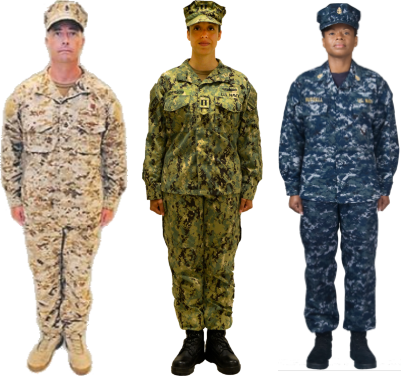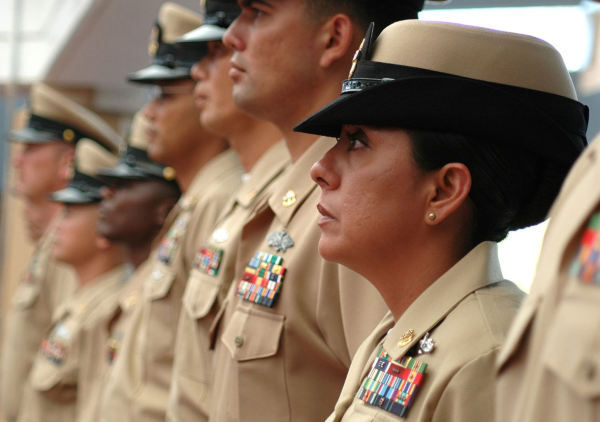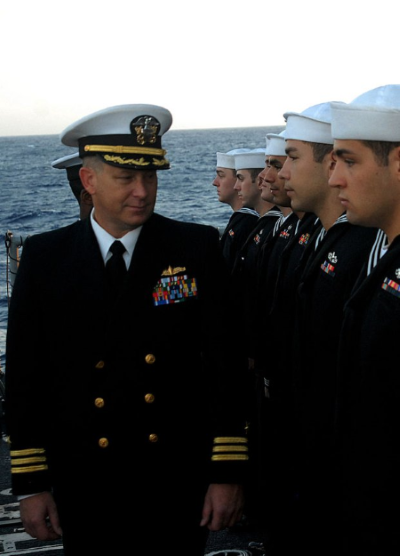The Navy has a long and storied history, and the uniforms that its sailors and commanders wear are a big part of that history.
Although the Navy has had to adapt its uniforms to changing strategic and working environments over the years, Navy uniforms still carry with them many of the old traditions in style and functionality.
Like other branches of the service, such as the Army, the Navy has three main uniforms that they use.
They include the Navy service uniform, the Navy dress uniform, and the Navy working uniform.
Of course, there are also other types of Navy uniforms that are job-specific, such as flight suits for Navy pilots.
Outlined here will be the most common Navy uniform types.
Related Article – Navy Grooming Standards: Hair, Mustache, and Nail Regulations
Navy Working Uniform

The Navy working uniform is its version of camouflage uniforms.
They are worn by Navy personnel in a wide variety of jobs and when deployed in the field or aboard ship.
Navy working uniforms are approved for use when commuting, associated stops, and for doing all Navy tasks during assigned duty hours.
Wearing this uniform after normal duty hours is not permitted.
Consumption of alcoholic beverages while wearing this uniform is also strictly forbidden.
Color Selection
There are several different versions of the Navy working uniform.
The color selection depends on the nature of the specific job that Navy personnel are doing.
For example; if working onboard a ship, blue coverall uniforms are usually the required working uniform.
The NWU Type II (desert) camouflage uniform is designated as organizational clothing, rather than service-wide.
Related Article – US Army Uniform Regulations
Cap
The cap of choice for this uniform is what is known as an 8-point cap. It’s crown-shaped on top with a baseball cap-style visor.
The cap must match the overall color of the particular working uniform being worn.
The cap must be worn squarely on the head in a manner where the visor is straight and worn just above the level of the eyes and parallel to the deck.
Rank insignias are never worn on the eight-point cap.
Shirt
The standard-issue Navy working uniform shirt is a NWU Type III with a spread collar.
As was mentioned, this shirt is primarily green, brown, and black, in a camo pattern called AOR2.
The tan Type II is now only worn by specialized units.
The NWU III shirt matches the trousers and other uniform components.
The normal way to wear the shirt is outside the waistband of the working uniform trousers. As for the collar, it is always worn down flat.
Sleeves are fastened at the cuff but may be rolled up if given approval by commanders for warm weather climates and other job scenarios.
The termination point when the sleeves are rolled is approximately 2 inches above the elbow. All buttons and closures are to be securely fastened at all times.
Related Article – Pros and Cons Of Joining The Navy
Undershirt
The undershirt is a solid 100% cotton crewneck in coyote brown color.
Trousers
Navy working uniform trousers are also camouflaged patterned.
The pants for the working uniform are Type III pants that are elasticized at the waist and have drawstrings at the bottom of the pant legs.
They must match the color of the shirt they are worn with and the other uniform components.
Navy working uniforms are worn fully fastened around the waist with the belt buckle centered on the front of the trouser.
Trouser legs shall be bloused using the attached drawstrings or blousing straps in a manner that covers the top three rows of the boot eyelets.
Underwear should never be visible when the working uniform is worn properly.
Boots
Standard footwear with the Navy working uniform is 8″ or 9” high safety boots.
They are usually black in color but there are exceptions when in the field or in unusual working environments.
Black working uniform boots are expected to be buffed and well-kept at all times.
Other color working boots do not have to be buffed but must be well-maintained.
Belt
The belt will be made of plain cloth or webbed material and must match the dominant color in the working uniform.
Men and women must wear the belt with the clip to the LEFT of the buckle.
Badges and Insignias
There are very few insignias that are allowed to be worn on this uniform and badges are rarely permitted.
Each Navy rank has specific insignia guidelines for the Navy working uniform.
Related Article – How To Get Into The US Naval Academy: 5 Challenging Steps
Alternative Navy Working Uniform
There is an alternative Navy working uniform that is worn for select jobs.
This is a coverall-type uniform.
The same restrictions for use as with the regular working uniform apply.
It is worn mainly by those in hands-on mechanical working environments and ship maintenance positions.
This alternative uniform is similar in style to the Navy service uniform and is worn in the same manner as that uniform.
Navy Service Uniform

Related Article: Navy Height And Weight Standards
The Navy service uniform is authorized to be worn for such things as office work, standing watch, on liberty, business onshore, and when prescribed by commanders as the uniform of the day.
The Navy service uniform comes in two different colors.
They are khaki with blue for most enlisted personnel and all khaki or summer whites for officers and chief petty officers.
Cap
The standard cap for both enlisted men and women when wearing the service uniform is the garrison cap.
This cap is easy to fold and maintain, which is what makes it so popular.
It must be worn squarely on the head, with the fore and aft crease centered vertically between the eyebrows.
At the lowest point, the cap must be approximately 1 inch above the eyebrows.
Officers and chief petty officers will have the option to wear a military-style combination cap.
Shirt
Most Navy members will wear khaki shirts with the service uniform.
The exception is those officers and chief petty officers that wear summer white uniforms.
The shirt shall remain tucked into the trousers at all times.
It should be long enough to remain tucked into the trousers even when reaching over the head or bending at the waist.
All buttons shall remain fastened at all times.
Related Article: Navy Height And Weight Standards
Undershirt
The color of the undershirt worn with the service uniform should be white.
It must be a rounded collar t-shirt and not a V-neck style t-shirt.
When the uniform is properly worn, only the very top color of the undershirt will be visible.
Trousers
The trousers must match the color of the uniform being worn.
For instance, khaki trousers must be worn with khaki shirts and uniforms.
White trousers are worn with white shirts.
The only exception is E-6 or lower enlisted ranks which wear black trousers with the khaki-colored shirt.
All the fasteners and buttons on a pair of trousers must be buttoned or closed at all times.
Trouser tops should fit comfortably around the hips.
Trousers shall be worn so that they hang approximately 1 to 2 inches off the floor at the back of the shoe.
Female service members have the option of wearing a black (enlisted) or khaki (officer) skirt, according to rank.
Related Article – Navy Tattoo Policy: What IS And What ISN’T Allowed
Footwear
Male officers and enlisted members will wear black, or white Oxford-style shoes with the appropriate service uniform.
These must be polished and well-kept.
Women of all ranks have the option of wearing Oxfords or low-heeled pumps with their service uniforms.
Belt
The belt is made of plain cloth or webbed material and must match the same color as the uniform.
Men must wear the belt with the clip to the left of the buckle.
Unlike the working uniform, female officers will wear the belt with the clip to the right of the buckle with slacks. The black slacks for enlisted women are not belted.
Badges and Insignia
Badges and insignia are permitted on the Navy service uniform.
Each rank and type of service uniform has specific guidelines for the ways that badges and insignia are to be worn.
Related Article – Navy PRT Standards For Males and Females
Navy Dress Blues

The Navy, like other branches of the military, has a specific uniform that each member wears to more significant or formal events.
Normally, Navy dress blues are worn by all Navy personnel for formal occasions, but officers and chief petty officers may also choose to wear summer dress whites at the appropriate time of year.
Cap
Officers and chief petty officers will wear a military-style combination cap with their dress blues.
Enlisted members will wear the traditional soft, white Navy cap with rounded tops and full-length stitched brims.
The brims must always be worn in an upright position.
Jacket
Female officers will wear a single-breasted jacket and for the men, it’s a double-breasted jacket.
All buttons on the coat must always remain buttoned when the coat is worn.
Related Article: US Navy Age Limits
Shirt/Jumper
A white dress-style shirt is the only shirt authorized to be worn with dress blues.
All buttons, including collar and sleeve buttons, must always be fastened.
Enlisted ranks of E-6 or below will wear a jumper-style shirt with no jacket for dress occasions.
The jumper is usually blue but may be white for summer or more formal occasions.
Jumpers are worn untucked and hanging straight at the sides.
Sleeves are to be bloused in a manner so that the bottom edge of the always-buttoned cuff covers the wrist bone when the elbow is bent and the arm is lying vertically across the front of the body.
Undershirt
The undershirt for officers will not be seen if the uniform is worn correctly so the color should not be an issue.
For enlisted of the ranks of E-6 and below, the undershirt is a white crew neck for both men and women.
Pants
The color of the Navy dress uniform pants will always match the color of the jacket or jumper being worn, according to the season and occasion.
According to Navy regulations, female sailors have the option of wearing a skirt with the service dress uniform coat or jumper.
Footwear
Clean and polished black dress shoes are always worn with any Navy dress uniform. White shoes will be worn with the white dress uniform.
Belt
The belt for officers and chief petty officers is black with service dress blues and white with service dress whites. They are made of plain cloth or webbing with gold clips.
Men must wear the belt with the clip to the left of the buckle.
Trousers for enlisted men wearing the service dress are unbelted.
Service dress uniform slacks or skirts for women may be unbelted, although there is an optional belted skirt option.
Related Article: 5 Best Navy Combat Jobs
Ties/Neckerchief
The ties worn with the Navy service dress blue uniform are black.
They must be tied with a traditional Windsor or half-Windsor knot.
When properly tied, the bottom of the tie must be 1” above the belt.
Ties are not worn with the higher collared Navy dress white uniform.
Enlisted members who are E-6 or lower will wear black neckerchiefs with the dress uniform.
These must be folded diagonally from corner to corner and then continuously rolled end to end.
The rolled neckerchief should then be tied with a large square knot at the bottom of the V-neck opening of the shirt.
Always make sure the upper edge of the knot is even with the point where the collar opens.
Badges and Insignia
All badges and insignia are permitted to be worn with all types of Navy dress uniforms.
There are strict guidelines for each style of uniform as to the manner in which insignias and badges are to be worn.
Related Article – Navy Jobs List: A List Of All 71 Ratings In The US Navy
Frequently Asked Questions
What organization within the Navy is responsible for maintaining the uniform regulations?
The Chief of Naval Operations is responsible for maintaining and updating all Navy Regulations. The U.S. Navy Uniform Regulations, NAVPERS 15665I, provides details on naval uniform policies.
Can you wear earrings in the Navy?
Only females may wear earrings in uniform and only small ball earrings. Women may wear small earrings approximately 1/8-1/4 inch in diameter of shiny or matte silver, gold, pearl, diamond, or a synthetic variation of those types. Commanding officers can restrict earrings if they’re a hazard to safety, however.
What is the Navy Service Uniform?
The Navy Service Uniform is suitable for office work and doing business onshore, as well as permitted on Liberty. It comes in khaki and black for enlisted personnel or khaki or white for officers and resembles business wear in the civilian world.
What is the Navy Working Uniform?
The Navy Working Uniform (NWU III) is similar to the camouflage worn by other branches. It is authorized for work as well as stops when commuting. Alternatively, another Navy Working Uniform is the dark blue coverall, worn when working conditions would cause severe damage to the uniform. Wearing the NWU is not permitted outside of normal duty hours.
When can I wear a Navy Dress Uniform?
Navy Dress Blues or Whites are appropriate for formal occasions such as ceremonies and state occasions. The distinctive jumper, called “crackerjacks” after the popcorn snack,” is worn only by enlisted below E-6. Officers and Chief Petty Officers may wear Dress Whites for summer.
Interesting Navy Uniform Facts
It was in August of 1791 that the first guidelines for distinctive dress in the Navy were introduced.
At first, these regulations only applied to officers but eventually, they became standard for enlisted personnel too.
The official Navy colors of blue and gold date all the way back to 1802.
That’s when the Secretary of the Navy first signed instructions that set the Navy pattern for dress.
The Navy has, for a long time, been known for its unique bell-bottom style on some of its sailors’ service uniforms.
Many people feel this was done to give these sailors’ uniforms a very distinct look but that’s not the case at all.
The original intent with Navy service uniforms and bell bottoms was to help make them easier to roll up when a sailor was swabbing the deck or doing other shipboard chores.
Many Navy uniform aspects and insignias are not something that just manifested themselves over time.
The Navy has actually used many British Naval Traditions as a guideline.
A good example of this is the Navy’s “Fouled Anchor” Insignia.
Before the US Navy started using this insignia, it was the official seal of Lord Howard of Effingham.
He was the British Lord Admiral whose planning and execution were instrumental in the defeat of the powerful Spanish Armada in 1588.
Related Article: 10 Best Jobs In The Navy For Civilian Life
References
https://www.public.navy.mil/bupers-npc/support/uniforms/Pages/UniformPhotos.aspx
- 5 Worst Jobs in the Air Force - June 20, 2024
- 4 Steps For Visiting An Air Force Recruiter Near You - June 19, 2024
- Air Force Safety Specialist (1S0X1) - June 19, 2024
Originally posted on March 20, 2022 @ 6:16 am
Affiliate Disclosure: This post may contain affiliate links. If you click and purchase, I may receive a small commission at no extra cost to you. I only recommend products I have personally vetted. Learn more.

My son is invited as a guest to a wedding in September. The bride and groom are civilians. This is a formal wedding and other guests will be in suits and gowns. Should my son be in his Navy dress uniform? Keep in mind he is not in the wedding party, just a guest.
Thanks
Hey Joyce,
I would definitely tell your son to get in touch with the bride and groom about this. Normally that wouldn’t be a problem, but you never know. Hope this helps and good luck!
Rob V.
OMK Founder